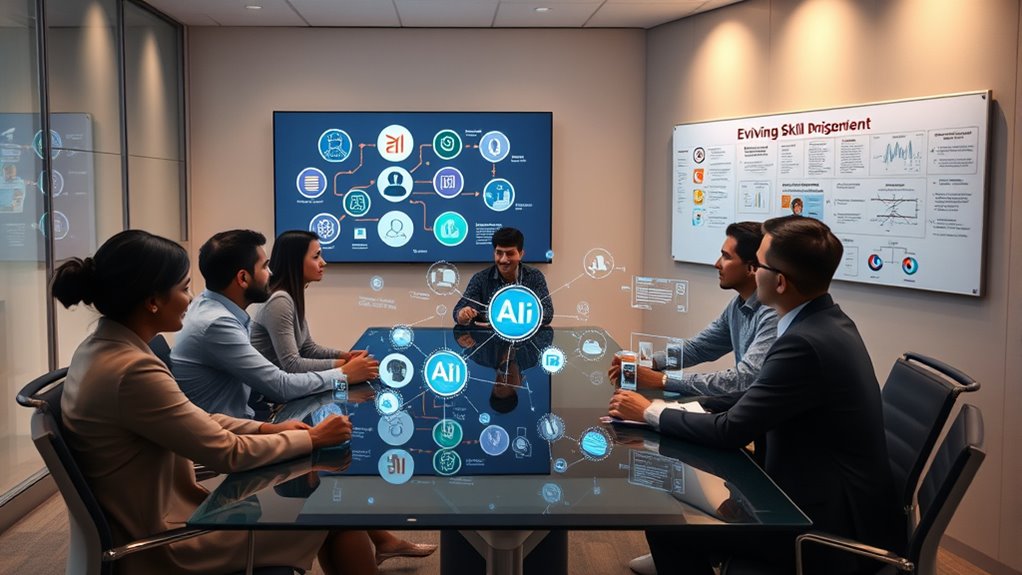In the age of automation and AI, reskilling is more critical than ever. You must stay ahead of rapid technological changes that quickly make skills outdated. While many organizations face challenges like high costs, infrastructure gaps, and employee motivation, industry-specific strategies and digital solutions can help. Leadership support and a culture of continuous learning are key to keeping pace. If you want to discover how to turn these challenges into opportunities, keep exploring further.
Key Takeaways
- Rapid technological change demands continuous, adaptive training to prevent skills obsolescence in the workforce.
- Many organizations face challenges like high costs and limited infrastructure hindering effective reskilling efforts.
- Industry-specific, targeted programs and microlearning help make training more relevant and accessible.
- AI and data-driven tools enable personalized, scalable learning to address individual skill gaps efficiently.
- Strong leadership and a culture of continuous development are essential to keep training pace with automation advances.
The Growing Urgency of Reskilling Amid Technological Change

As technology rapidly advances, the need for reskilling becomes more urgent than ever. AI and digital tools are transforming workplaces at a breakneck pace, making many current skills outdated. Nearly 44% of workers will see their skills disrupted in the next five years due to these technological shifts. Employers recognize this, with 40% already implementing mature upskilling programs. Meanwhile, younger workers like Millennials and Gen Z demand growth opportunities; 74% are willing to leave jobs that lack them. The World Economic Forum’s Reskilling Revolution aims to empower a billion people by 2030. Whether through on-the-job training, nondegree credentials, or earn-and-learn programs, staying ahead requires continuous learning. Reskilling isn’t just a choice; it’s a necessity in today’s rapidly changing job landscape. Broadening digital access is expected to transform 60% of businesses by 2030, making reskilling essential for both employees and employers to remain competitive. Additionally, fostering a culture of continuous learning can help organizations adapt more effectively to technological disruptions. As industries evolve, the importance of upskilling in emerging technologies will only grow, ensuring workers can meet new demands head-on. Developing creative practice skills can also play a crucial role in fostering innovation and adaptability in this shifting environment. Incorporating specific skill assessments can help tailor training programs to meet evolving industry needs. Moreover, integrating hands-on training methods can enhance practical understanding and retention among learners.
Key Challenges in Workforce Training for AI and Automation

You face significant hurdles in workforce training for AI and automation, including high costs that limit access for many workers. Skills gaps grow wider as rapid technological changes outpace existing training programs, making it hard for employees to stay current. Additionally, engaging workers in retraining efforts remains challenging, especially when motivation and resource availability are low. AI’s transformative impact means that the need for continuous learning is more urgent than ever, further complicating training initiatives. The importance of quality assurance practices in ensuring effective training outcomes highlights how staying updated with the latest advancements is vital for adapting training methods effectively. Furthermore, understanding sound healing science can inspire innovative approaches to employee wellness programs, fostering better engagement in retraining efforts. Incorporating remote hackathons into training strategies can also facilitate collaborative learning and skills development across diverse teams.
Cost Barriers to Training
Cost barriers pose a significant challenge to workforce training for AI and automation, often limiting how quickly companies can prepare their employees for new technologies. High upfront costs for implementing automation, infrastructure upgrades, and ongoing maintenance strain budgets, especially for small businesses with limited resources. Training expenses are particularly steep, yet only 8% of organizations provide formal programs, leaving many employees unprepared. Limited budgets force companies to prioritize investments, often delaying or forgoing essential training. For small businesses, the challenge is even greater—they struggle to scale automation efforts and compete with larger firms that can afford extensive training and infrastructure. These financial constraints hinder rapid adaptation, making it difficult for organizations to keep pace with technological advancements. Additionally, the lack of accessible preppy dog names can limit opportunities for workforce engagement and morale boosting initiatives. Recognizing the importance of cost-effective training solutions can help organizations overcome some financial hurdles and better prepare their workforce for ongoing technological changes. Furthermore, leveraging flexible learning platforms can provide more affordable and scalable options for employee upskilling. Developing strategies that address these cost barriers is essential for fostering a resilient and adaptable workforce in the era of automation.
Skills Gap Challenges
Rapid technological advancements in AI and automation are transforming job requirements faster than many training programs can adapt, creating a significant skills gap. Nearly 25% of jobs worldwide will change in the next five years, demanding new skills in language, voice, and image processing. Many traditional skills become obsolete as organizations shift toward tech-driven roles requiring advanced digital abilities. The speed of innovation outpaces current training efforts, leaving workers unprepared. Identifying which skills will matter soon proves difficult, complicating workforce planning. Demographic shifts like retiring baby boomers and declining labor participation worsen the shortage of experienced workers. Meanwhile, existing training often doesn’t align with industry needs, making it harder for you to develop relevant skills and stay competitive in an evolving job market. Skills gap threatens to turn into a skills chasm, emphasizing the urgent need for scalable and responsive reskilling infrastructure. Additionally, integrating emerging technologies such as AI-powered tools into training programs can help bridge this gap more effectively, especially when combined with adaptive learning methods that personalize skill development.
Training Engagement Difficulties
As organizations endeavor to close the skills gap created by fast-paced technological changes, engaging employees in workforce training becomes a significant hurdle. Nearly half of employees want more formal training to support AI adoption, but many feel unprepared or unsure about their data privacy rights, which can dampen motivation. Fear of job loss also weighs heavily—65% of US workers worry about being replaced by AI—reducing their willingness to participate. Additionally, inadequate technological infrastructure and varying training quality hinder accessibility and engagement. Resistance to change, concerns about relevance, and the need for clear communication further challenge participation. To succeed, you must develop relevant, accessible, and transparent training programs that motivate and involve employees, addressing their fears and ensuring ongoing engagement.
Industry-Specific Strategies for Upskilling Employees

You need targeted training programs that fit your industry’s unique needs, ensuring employees gain relevant skills quickly. Leveraging sector-specific technologies helps your team stay ahead in automation and innovation. Additionally, cross-industry skill transfer allows you to adapt workforce expertise across different sectors, maximizing reskilling efforts. Incorporating efficient equipment training ensures your team can operate tools like airless spray systems effectively and safely. Recognizing the importance of industry-specific support hours and operational schedules can help tailor training sessions to minimize downtime and improve overall productivity. Incorporating bicycle tire maintenance techniques into training programs can enhance employees’ ability to perform routine inspections and prolong equipment lifespan, ultimately reducing operational costs. Understanding training adaptability in various operational contexts can further improve the effectiveness of your upskilling initiatives. Recognizing the importance of ice cream flavors diversity can inspire adaptable problem-solving approaches in various operational contexts.
Tailored Industry Training Programs
Tailored industry training programs are essential for effectively upskilling employees by aligning learning content with specific sector needs and job roles. By customizing curricula around current and emerging skills—like digital literacy in manufacturing or compliance in finance—you ensure relevance and practical application. Incorporating real-world scenarios and industry-specific case studies reinforces learning transfer, making training more impactful. Sector-driven competencies are identified through analysis of business objectives and anticipated skill disruptions, keeping programs responsive to industry shifts. Collaborating with industry experts helps keep training current with trends and regulations. These targeted initiatives directly support strategic business goals, boost employee engagement, and reduce turnover. By focusing on sector-specific needs, you create a more effective upskilling process that prepares your workforce for ongoing technological and market changes.
Leveraging Sector-Specific Technologies
Leveraging sector-specific technologies is essential for staying competitive in today’s rapidly evolving market landscape. Industries are integrating advanced tools like blockchain, IoT, and cloud computing to enhance operations and meet customer demands. For example, finance sectors rely on fintech innovations to expand digital payment services, creating high demand for specialized skills. As these technologies become central to business success, you’ll need targeted upskilling programs, such as microlearning, to keep pace. Overcoming challenges like data privacy and security is vital, especially as sectors face unique threats. Failing to adopt these innovations risks losing revenue and market share. By focusing on industry-specific tech integration, you prepare your workforce not just to adapt but to lead in a competitive, tech-driven environment. Incorporating sector-specific skills into employee training ensures teams are well-equipped to navigate ongoing technological changes. Additionally, understanding cost and budgeting factors helps organizations plan for the investments needed in new technology adoption. Developing a comprehensive understanding of market trends can also give your organization a strategic advantage in adopting emerging innovations. Incorporating wellness practices like yoga into employee wellness programs can also improve focus and reduce stress, enhancing overall productivity and adaptability in the workplace.
Cross-Industry Skill Transfer
As industries continue to incorporate sector-specific technologies, the ability to transfer skills across different fields becomes increasingly valuable. You’ll find that human-centered skills like communication, problem-solving, resilience, and adaptability are in high demand across sectors. Transferable skills such as leadership, time management, and data analysis enable seamless progression between industries. Companies are investing in upskilling initiatives, cross-training, and industry partnerships to facilitate this mobility. Talent mobility is expanding globally, but the shrinking, specialized talent pool makes international recruitment essential. Soft skills like teamwork and empathy remain indispensable for cross-industry success. Emphasizing continuous learning and skills-based hiring helps you stay adaptable, empowering you to navigate industry shifts confidently and seize new opportunities in a rapidly changing job landscape. Recognizing the importance of emotional support in upskilling efforts can also enhance employee resilience and engagement during transitions.
Overcoming Cost Barriers in Workforce Development

Overcoming cost barriers in workforce development requires strategic approaches that make training programs more affordable for employers. You can tap into several effective strategies:
- Utilize financial incentives like tax credits and state-level support to offset training expenses.
- Leverage public-private partnerships, such as apprenticeships and shared funding, to distribute costs.
- Access targeted grants from federal and state programs, especially for high-demand industries.
- Partner with community colleges and vocational institutions to develop subsidized, low-cost training options.
These initiatives help reduce upfront costs, making reskilling more accessible. By combining incentives, collaborations, and affordable delivery methods, you can overcome financial hurdles that might otherwise hinder workforce development efforts.
Addressing the Skills Gap Across Multiple Generations

Workforce development efforts must address the unique needs of multiple generations to close the skills gap effectively. By 2034, Millennials, Gen Z, and Gen Alpha will make up 80% of the workforce, each with different learning styles and technological skills. Gen Z pushes for more flexibility and digital fluency, while older workers often need more extensive reskilling to keep pace with automation. Tailored training programs that consider these differences boost engagement and success. Intergenerational knowledge transfer is essential, helping bridge skills gaps and foster collaboration. Addressing barriers to entry for older and underrepresented workers, along with flexible learning options, enhances inclusion. Emphasizing skills-based hiring and mentorship opportunities further supports a diverse, adaptable workforce prepared for rapid technological change.
The Role of Digital Transformation in Reskilling Initiatives

Digital transformation acts as a powerful catalyst for reskilling initiatives, driving organizations to adapt their workforce to rapidly changing technologies. It not only enhances performance—63% of companies saw improvements—but also boosts profits, with 87% leveraging tech for growth. To keep pace, you need to focus on:
- Identifying digital skills gaps, especially in AI, data analytics, and cybersecurity.
- Implementing scalable digital platforms like e-learning and microlearning modules.
- Using AI-powered tools for personalized training tailored to individual needs.
- Securing strong leadership commitment to foster a continuous learning culture.
Ensuring Organizational Readiness for AI Maturity

Achieving AI maturity requires organizations to thoroughly assess their current capabilities and readiness levels. While 84% of executives expect significant benefits from AI, only 12% of firms have advanced enough to harness AI for growth and transformation. Most, about 63%, remain in early stages, struggling with data quality, infrastructure, and strategy. Many are still experimenting with AI tools, and only 1% believe they’ve reached full maturity. A major obstacle is the lack of confidence in data-AI readiness, with 60% of leaders feeling unprepared. Critical factors include establishing clear AI strategies, improving data management, investing in scalable technology, and fostering R&D. Without these foundational elements, organizations can’t access AI’s full potential, hindering their ability to compete and innovate effectively.
The Economic and Social Benefits of Worker Reskilling

Reskilling offers both economic and social advantages that can transform organizations and communities alike. By investing in worker development, you can:
- Boost productivity, making your organization more competitive.
- Achieve quick returns, with over 60% of employers seeing ROI within a year.
- Fill skills gaps created by technological changes, ensuring smooth transitions.
- Improve job retention, lowering turnover costs and maintaining continuity.
On the social side, reskilling enhances job security, as 68% of workers are willing to learn new skills. It opens economic opportunities, helping workers increase income and stability. Additionally, it promotes workforce diversity across education levels and ages, fostering societal growth and stability. Reskilling benefits everyone, creating a more adaptable, resilient economy.
Future Trends and Priorities in Employee Training

As organizations recognize the value of worker reskilling, they’re increasingly turning to innovative training methods to meet evolving demands. AI will play a central role, offering personalized learning experiences tailored to your needs and learning styles by 2025. AI-powered coaching systems will act as virtual mentors, providing real-time feedback and adapting to your progress. Additionally, AI will identify your skill gaps and deliver targeted training to help you bridge them efficiently. Data-driven insights from AI analytics will monitor your performance and program effectiveness. Emerging technologies like virtual and augmented reality will make training more immersive and engaging, while nano learning sessions will fit modern work patterns. Prioritizing soft skills, leadership, and adaptability will remain key to preparing you for future workplace challenges.
Frequently Asked Questions
How Can Small Businesses Afford Comprehensive AI Reskilling Programs?
You can afford extensive AI reskilling programs by leveraging affordable online courses, free platforms like ChatGPT, and subscription-based tools with built-in tutorials. Partner with local colleges or workforce programs for subsidized training. Focus on targeted, modular courses tailored to your business needs, and use scalable, off-the-shelf AI solutions that include employee training. These strategies keep costs manageable while ensuring your team stays current with AI advancements.
What Are the Most Effective Methods to Motivate Different Generations to Learn New Skills?
You can motivate different generations to learn new skills by understanding their unique preferences. Offer personalized feedback, create flexible learning schedules, and foster collaborative environments. Recognize achievements with rewards that resonate, like intrinsic challenges for Baby Boomers or career growth for Gen Z. Use technology to engage younger groups and emphasize shared values like respect and fairness. Tailoring your approach helps keep every generation motivated and enthusiastic to upskill effectively.
How Do Organizations Measure Success in Their Reskilling Initiatives?
You measure success in reskilling initiatives through key metrics like completion rates, which show engagement, and skill acquisition, assessed via tests or performance reviews. Employee satisfaction surveys reveal relevance, while ROI calculations compare costs to benefits. Additionally, tracking time to proficiency and behavioral changes helps you understand how effectively employees apply new skills. Monitoring organizational impacts like retention, promotion rates, and strategic alignment completes an all-encompassing picture of success.
What Role Do Government Policies Play in Supporting Workforce Retraining?
Government policies act like a compass, guiding workforce retraining efforts amid rapid automation. They support industry-aligned training programs, fund apprenticeships, and create data systems to boost efficiency. These policies empower you through certifications and regional flexibility, making training more accessible and targeted. By continuously evaluating outcomes and encouraging employer involvement, government policies help you adapt to changing job markets and ensure your skills stay relevant in a tech-driven world.
How Can Companies Ensure Equitable Access to Training Across All Employee Demographics?
You can guarantee equitable training access by actively promoting inclusivity and removing barriers. Offer tailored programs for marginalized groups, involve diverse employees in planning, and make DEI training mandatory. Regularly assess participation and feedback to identify gaps. Allocate resources fairly, even amid budget constraints, and foster a culture that values diversity. By doing so, you create an environment where every employee has equal opportunity to develop skills and contribute fully.
Conclusion
As automation reshapes your workplace, imagine embracing change like planting seeds in fertile ground, watching your team grow stronger. While costs may seem like barriers, investing in reskilling sparks a vibrant future—bright and full of opportunity. Just as technology advances swiftly, your commitment to continuous learning keeps your organization resilient. In this evolving landscape, staying ahead isn’t just about machines; it’s about empowering your people to thrive amidst the digital dawn.









